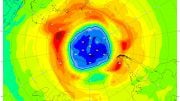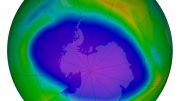
Another reason to reduce man-made ozone: To cool a warming planet.
Lehigh University scientist Benjamin S. Felzer calls new research showing that cleaning up ozone precursors within energy, industrial and transportation sectors could mitigate climate change, a ‘win-win’ — for both human health and the planet.
While elected officials in the U.S. debate a proposed “Green New Deal” and U.S. President Donald Trump derides “prophets of doom” in Davos, environmental scientists continue to gather evidence about how changes to industry could mitigate the harms of climate change.
In a News and Views article in Nature Climate Change (“Cleaner Air is a Win-Win”) Lehigh University Professor of Earth and Environmental Science, Benjamin S. Felzer, highlights the importance of a new analysis based on Earth system modeling, showing that cleaning up ozone precursors within specific economic sectors can increase the mitigation potential of the land carbon sink by enhancing the ability of vegetation to remove carbon dioxide from the atmosphere through photosynthesis. Global climate models, he notes, indicate that ozone limits photosynthesis and vegetation growth in polluted regions such as the eastern United States, eastern China, and Europe which, in turn, limits the ability of these regions to act as carbon sinks.
Felzer writes: “The study [by Nadine Unger et al]…assesses the effect of reducing ozone precursors in seven different economic emission sectors, the most important of which turn out to be energy (electricity and heat production from fossil fuel burning), industry (fossil fuels burned on site), road transportation and agriculture.
Unger et al. ran an Earth system model, linking climate to atmospheric chemistry, to explore the global effects on photosynthesis of reducing emissions from these sectors by 50%. Ozone pollution resulted in 9-13% reductions in photosynthesis in the aforementioned polluted regions. Cleaning up ozone precursors in the transportation, energy, industrial or agricultural sectors led to 13-16% gains in photosynthesis in eastern China, and 16-23% gains in the eastern United States and Europe due to the transportation and energy sectors. Benefits were 2-3 times larger in croplands and grasslands than in forests. A 50% reduction in ozone pollution from just the transportation and energy sectors resulted in an increase in photosynthesis equivalent to the amount of carbon lost by fire each year.”
According to Felzer, Unger and colleagues ultimately conclude that the mitigation potential resulting from addressing ozone pollution would result in a 15% increase in the size of the current land sink for carbon.
How reducing ozone precursors could slow down the impacts of climate change
From the perspective of human health impacts, there is “good” ozone and “bad” ozone. Natural ozone in the second major layer of Earth’s atmosphere has a protective effect for humans, blocking the sun’s harmful ultraviolet (UV) rays. Man-made ozone, a byproduct of fossil fuel production and other industrial processes, gets trapped in the atmospheric layer closest to earth and has been shown to be harmful to human health, as well as to plants, trees, and crops.
Man-made ozone at ground-level inhibits plant photosynthesis by directly damaging some of the plant cells responsible for it.
“It affects different plants differently, for example doing more damage to crops than to trees at similar doses…,” he writes. “Global climate models indicate that ozone limits photosynthesis and vegetation growth in polluted regions such as the eastern United States, eastern China, and Europe…This then reduces the carbon sequestration potential of these regions…”
Reducing ozone, concludes Felzer, will help vegetation to grow better and take up more Carbon Dioxide, while also reducing unhealthy pollutants such as nitrogen oxides and volatile organic compounds (VOCs).
Political debates and rhetoric aside, it is a conclusion that supports reducing man-made ozone for the health of humans, as well as the planet on which all life depends.
References:
“Cleaner air is a win–win” by Benjamin S. Felzer, 27 January 2020, Nature Climate Change.
DOI: 10.1038/s41558-019-0685-4
“Mitigation of ozone damage to the world’s land ecosystems by source sector” by Nadine Unger, Yiqi Zheng, Xu Yue and Kandice L. Harper, 27 January 2020, Nature Climate Change.
DOI: 10.1038/s41558-019-0678-3









Be the first to comment on "Reducing Man-Made Ozone: A ‘Win-Win’ for Both Human Health and the Planet"